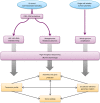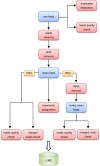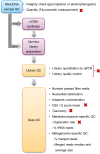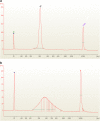Viral to metazoan marine plankton nucleotide sequences from the Tara Oceans expedition
- PMID: 28763055
- PMCID: PMC5538240
- DOI: 10.1038/sdata.2017.93
Viral to metazoan marine plankton nucleotide sequences from the Tara Oceans expedition
Abstract
A unique collection of oceanic samples was gathered by the Tara Oceans expeditions (2009-2013), targeting plankton organisms ranging from viruses to metazoans, and providing rich environmental context measurements. Thanks to recent advances in the field of genomics, extensive sequencing has been performed for a deep genomic analysis of this huge collection of samples. A strategy based on different approaches, such as metabarcoding, metagenomics, single-cell genomics and metatranscriptomics, has been chosen for analysis of size-fractionated plankton communities. Here, we provide detailed procedures applied for genomic data generation, from nucleic acids extraction to sequence production, and we describe registries of genomics datasets available at the European Nucleotide Archive (ENA, www.ebi.ac.uk/ena). The association of these metadata to the experimental procedures applied for their generation will help the scientific community to access these data and facilitate their analysis. This paper complements other efforts to provide a full description of experiments and open science resources generated from the Tara Oceans project, further extending their value for the study of the world's planktonic ecosystems.
Conflict of interest statement
The authors declare no competing financial interests.
Figures






Dataset use reported in
- doi: 10.1126/science.1261498
- doi: 10.1126/science.1261605
- doi: 10.1126/science.1261359
- doi: 10.1038/nature19366
References
Data Citations
-
- 2015. GenBank. NC_001422.1
-
- 2012. European Nucleotide Archive. PRJEB402
-
- Tara Oceans Consortium C., Tara Oceans Expedition P. 2015. PANGAEA. http://dx.doi.org/10.1594/PANGAEA.859953 - DOI
-
- Alberti A., Pesant S. 2017. PANGAEA. https://dx.doi.org/10.1594/PANGAEA.875581 - DOI
References
-
- Gilbert J. A. & Dupont C. L. Microbial metagenomics: beyond the genome. Ann Rev Mar Sci 3, 347–371 (2011). - PubMed
-
- Temperton B. & Giovannoni S. J. Metagenomics: microbial diversity through a scratched lens. Curr. Opin. Microbiol. 15, 605–612 (2012). - PubMed
-
- Venter J. C. et al. Environmental genome shotgun sequencing of the Sargasso Sea. Science 304, 66–74 (2004). - PubMed
Publication types
MeSH terms
Substances
LinkOut - more resources
Full Text Sources
Other Literature Sources

